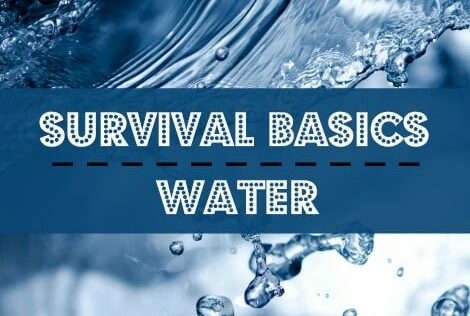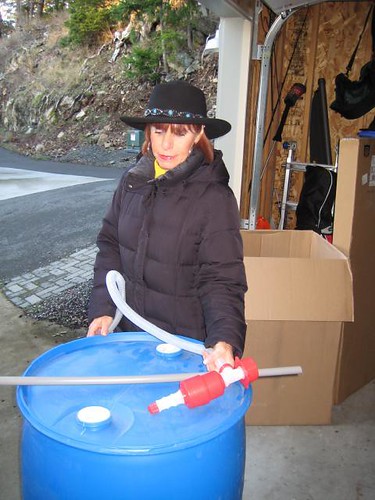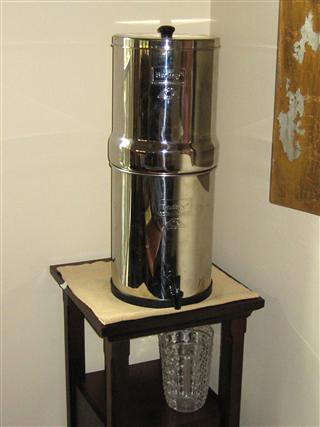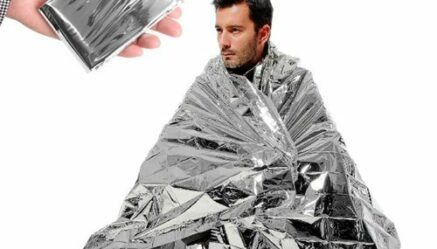This site contains affiliate links. As an Amazon Associate, I earn a commission from qualifying purchases at no extra cost to you. Full Disclosure Here.
During a recent book giveaway, the question asked was “What piece of prepping gear is at the top of your bucket list?” Needless to say, I was more than a little bit surprised to find that the top response was water storage, water filters, and water purification equipment.
While having the gear is nice, anyone interested in preparedness also needs to have a basic understanding of the concepts behind water and water storage. Where to find, store, purify, and filter water are all questions that need to be asked, answered, and periodically reviewed.
And why do I know that? A couple of months ago I was personally without running water for 12 days. Being up to speed on the do’s and don’t of water were key to my getting by just fine during this period.
With that in mind, today I share an article on the water as a survival basic.
Back to the Basics: Water for Survival
When I first started Backdoor Survival, my focus was on gathering the basics: food, water, shelter, and fire. Of course, along the way, I have learned that there is so much more that is essential to long-term survival. Things that come to mind are clean air, clothing, first aid, self-defense, signaling and a community with others.
But today I want to keep things simple and, for the benefit of my newer readers, go back the basics and review the essentials of water for survival.
Water is the Most Important Survival Basic
Clean water is something that we all take for granted. We turn on the faucet and there it is. It is plentiful, it is clean and it is drinkable. Yes, it may have some undesirable chemical additions such fluorides, but for the most part, having clean, drinkable water is something we have come to rely upon.
The bottom line is that if a disaster occurred and the supply lines to fresh water were comprised, we would be in a pickle. There is a possibility that safe water would not be available for days and possibly not for weeks.
The rule of thumb propagated by FEMA and just about every other authority out there is that you store at least one gallon of water per person and pet, per day, for a minimum of three days. But if you think that a three-day water supply is adequate, think again.
A more reasonable recommendation is that you up the recommended amount of stored water to a two week supply. So for two people that would be 2 people x 1-gallon x 14 days = 28 gallons. This amount should cover your minimal needs for drinking, food preparation and nominal, and I mean nominal, hygiene.
DIY Water Storage
Storing water for an emergency can be as simple as filling thoroughly washed plastic or glass containers with tap water and sealing them tightly. This is something that anyone can do without incurring a cost so long as few simple rules are followed.
Here are steps to take to store water for emergency use:
1. Thoroughly clean your plastic bottle and jugs with dishwashing soap and water then rinse completely so there is no residual soap.
2. Sanitize your bottles by adding a solution of 1 teaspoon of un-scented liquid household chlorine bleach to a quart of water. Swish the sanitizing solution in the containers so that it touches all interior surfaces. Don’t forget to sanitize the lids and caps as well. After sanitizing the containers and caps, thoroughly rinse out the bleach solution with clean water.
Note: Bleach has an effective shelf-life of one year. Make sure that the bleach you are using is fresh.
3. Fill the sanitized containers to the top with regular tap water. Add two drops of non-scented liquid household chlorine bleach to the water, then tightly close the containers using the original caps. It is probably a good idea to use some latex or nitrile gloves at this point so that you maintain the sanitation and do not contaminate the caps by touching the inside of them with your fingers.
4. Date the outside with a permanent marker such as a Sharpie.
5. Store in a cool, dark place.
6. As a precaution, rotate in six months to a year. Dump the water, re-sanitize the jugs, and start all over. Or, if you have the space, mark the jugs as “non-potable” and save the water for non-drinking emergency purposes.
Personally, I think it would be a good idea to put up a few jugs at the first of each month. Do this for six months and you will build up a nice, rotating stock.
Plastic soda bottles or juice jugs work well for DIY water storage. On the other hand, milk jugs should not be used for water storage. Milk and protein sugars are difficult to remove and will compromise the stored water because they create an environment for bacteria growth. In addition, milk jugs are flimsy and will not hold up, even for a short period of time. Ditto cardboard. The cardboard will eventually leak and make a big mess. Glass is okay but be aware that glass is heavy and subject to breakage.
Water stored as described above will be good for at least six months to a year and possibly longer. Let me be clear: you rotate water not because it has an “expiration date” but that it may become chemically or biologically contaminated and foul. Why take a chance?
Technically, if the water is stored in a cool, dark area and away from chemical and toxic fumes, it should last forever.
If the cleanliness of the water is in question, it can be purified with purification tablets, fresh bleach, or a filtering system such as the Berkey or LifeStraw, among others.
If you need some help figuring out which water filter system is best for you, take the quiz below:
[v4_product_quiz_wp quiz-slug=’water-filter-quiz’]
If you have space and the budget, you can also purchase food-grade plastic containers and drums designed for water storage. These containers typically hold up to 55 gallons of water and with the addition of proper purification chemicals, will keep the water safe for up to five years.
I personally have a 55-gallon water storage system. It was easy to set up and it came outfitted as a complete kit with all of the various tools and siphons I will need if/when that emergency situation occurs.
Another alternative, of course, is bottled water. The same rule applies: store in a cool, dark area and periodically rotate just to be on the safe side.
Hidden Sources of Water
In addition to tap water, there are other hidden sources of water that you can use when a disaster occurs. These sources include the water in your hot water heater, pipes, and even the ice cubes from the ice maker in your refrigerator or freezer. Before tapping into these sources, however, you will first need to shut off the main valve coming into your home so that you do not contaminate the ”good” water with the “bad”.
Here are some specific instructions for using the water in your hot water tank:
- Turn off the electricity or gas.
- Open the drain at the bottom of the tank.
- Start the water flowing by turning off the water intake valve at the tank and turning on a hot-water faucet.
- And don’t forget: be sure to refill the tank before turning the gas or electricity back on.
Outdoor Sources of Water
Barring the use of stored water or the hidden water sources in your home, there is always the outdoors. Water may be available from rainwater, streams, ponds, lakes and natural streams. Absolutely stay away from flood water since it is likely to contain sewage and other nasties that you do not even want to think about.
When using outdoor sources of water, you are going to have to undertake purification measures to make it safe. There are many ways to purify water, some better than others and some easier than others.
Water Purification
For ad hoc water purification, nothing beats plain old bleach as long as it is fresh (no more than a year old) and unscented.
According to the Clorox website: When boiling off water for 1 minute is not possible in an emergency situation, you can disinfect your drinking water with Clorox® Regular-Bleach as follows:
1. Remove suspended particles by filtering or letting particles settle to the bottom.
2. Pour off clear water into a clean container.
3. Add 8 drops of Clorox® Regular-Bleach (not scented or Clorox® Plus® bleaches) to one gallon of water (2 drops to 1 quart). For cloudy water, use 16 drops per gallon of water (4 drops to 1 quart).
Boiling water is considered the safest method of purifying water. What you do is bring water to a rolling boil for three to five minutes. The water may not taste that great but it will be safe to drink.
Factoid: To improve the taste of boiled or stored water, you can put some oxygen back in to the water by pouring it back and forth between two containers.
As an alternative to bleach or boiling water, the EPA has guidelines for using calcium hypochlorite, commonly sold as “pool shock” to disinfect water:
Add and dissolve one heaping teaspoon of high-test granular calcium hypochlorite (approximately ¼ ounce) for each two gallons of water, or 5 milliliters (approximately 7 grams) per 7.5 liters of water.
The mixture will produce a stock chlorine solution of approximately 500 milligrams per liter, since the calcium hypochlorite has available chlorine equal to 70 percent of its weight. To disinfect water, add the chlorine solution in the ratio of one part of chlorine solution to each 100 parts of water to be treated.
This is roughly equal to adding 1 pint (16 ounces) of stock chlorine to each 12.5 gallons of water or (approximately ½ liter to 50 liters of water) to be disinfected. To remove any objectionable chlorine odor, aerate the disinfected water by pouring it back and forth from one clean container to another.
Tip: For more precise (and in my opinion better) instructions, visit the article How to Use Pool Shock to Purify Water. In this article, I go into great detail describing plus showing you how to safely use Pool Shock for water purification purposes.
A good reference for this and other purification methods can be found in the downloadable and printable article Emergency Disinfection of Drinking Water.
What About Water Filters?
The use of water filters to make raw water drinkable is another solution to the water for survival dilemma. The nice thing about a filtration system is that it will not only supplement your stored water but will provide you with great tasting, chemical-free drinking water for day to day.
I personally have a Royal Berkey and to tell the truth, wonder what took me so long to discover this alternative to purchased water in bottles and a countertop Brita.
This is not to say that I don’t have bottled water because I do. After all, if I have to leave my home, it would be tough to drag along a 55-gallon water barrel or a Berkey. But for day to day drinking as well as long term survival needs, you simply can not beat a quality filtration system.
Portable Water Filters
I have had good luck with the LifeStraw Personal Water Filter. This lightweight and affordable filter is like an oversized straw. You can use it with a cup or dip it directly into a pond or stream. There are other portable water filtering systems as well and these are handy to keep in your emergency backpack, your car or your travel kit.
Additional Reading
I have written about various aspects of water for survival purposes. Here are some additional articles for you to peruse as time and interest dictates.
16 Tips for Coping Without Running Water
The Five Myths of Water Storage
How to Use Pool Shock to Purify Water
8 Reasons to Drink Water for Survival
15 Ways to Conserve Household Water Now
The Final Word
If you decide to check into this, be sure to confirm that the original contents were food products. Clean them well first with vinegar and baking soda to remove odors, and then with a strong bleach for sanitation.
Here in my area, there is a fellow that sells such barrels and will even add a hose bib at the bottom for a nominal cost. I am not 100% sure I would drink from such a barrel but the water inside should be great for bathing, laundry and housekeeping chores.
Another reader has suggested the use of colloidal silver get rid of bacteria in the water. I have not researched this personally, however.
Whatever your water storage method of choice, I highly recommend that you store at least two weeks of water for every member of your household, including pets. Please remember that depending on climate conditions, you can only survive for an average of three to five days without the intake of water.
Why take a chance when it is so easy to store water?
Should You Store Commercial Bottled Water?
There are pros and cons to using bottled water for your survival water. The obvious benefit of buying bulk containers of water that are usually packaged to be neatly stacked is hard to overlook, plus you are buying a relatively pure product that has been bottled under sanitary conditions – all important aspects to consider when assembling your survival water supply. But there are problems with bottled water that may leave you deciding against storing it, or to just store a minimal amount to see you over a hump.
- Bottled water is not environmentally friendly. The bottles are a massive use of plastic, and will pile up fast if you rely on a bottled water supply during an emergency. Not only can disposal pose a problem, if you are a prepper concerned about the environment, then you know water bottles are terrible, no matter how you slice it.
- Bottled water isn’t always ethically sourced. Some multinational corporations seem content to drain aquifers, or pump millions of gallons a year from rural areas, and ship it in overpriced bottles to satisfy the trendy thirst of folks in the big cities. The end result is big profit for some, and lost resources for others.
- Commercial bottled water isn’t made for long term use. When stored in extreme conditions, plastic can degrade and leech chemicals. Unsurprisingly, extreme conditions are usually when preppers need their water the most. Do you really want plastic flavored water? I don’t.
- As plastic degrades, bottles can start leaking. The exception to this is the large bottles made for office water dispensers. These are made to be refilled and do not break down like single serve water bottles and the gallons of water you can find at any grocery store during good times.
- It is expensive. Gallon for gallon, bottled water is a drain on your wallet. Now it’s one thing to put a dozen or so gallons aside, it’s another to make your entire water storage strategy revolve around expensive bottled water. Consider the financial cost of more than a couple days worth of drinking water in commercial bottles.
Of course there are obvious benefits, like not having to think about doing any of the bottling yourself, being able to throw a couple bottles in an emergency kit, or a couple cases in your car, or stacking boxes of gallon jugs in your closet.
The clever prepper will balance the environmental, social and financial costs of commercial bottled water against its utility. Only you can judge what level of utility bottled water offers you and how to balance that in your preps. Some folks may rely more heavily on bottled water than others, but that has to be your choice. At the very least, a balanced supply in commercial bottles, 55 gallon drums, and home filled containers will give you more options than just relying on a single source of stored water.
Bottled water has a place, but it probably shouldn’t be your primary source of water. It can be expensive, and harmful to the environment, may be in easily degradable packaging, and is usually the least efficient storage method of water. However, it offers great convenience, is easily portable, and the containers can be reused several times over. By balancing the good and the bad of bottled water, you can be more secure in your preps.
~~~~~
Below you will find the items related to today’s article.
LifeStraw Personal Water Filter: The LifeStraw is considered the most advanced, compact, ultralight personal water filter available. It contains no chemicals or iodinated resin, no batteries and no moving parts to break or wear out. It weighs only 2oz. making it perfect for the prepper. For more information, see my LifeStraw review.
Potable Aqua Water Treatment Tablets: Potable Aqua Water Purification Tablets make questionable water bacteriologically suitable to drink. Easy to use and the water is ready to drink in 30 minutes. One 50 tablet bottle treats 25 quarts of water.
WaterBrick Water Storage Containers: I have not tried these myself but I do know that many Backdoor Survival readers prefer these water bricks to 55-gallon water barrels.
No Rinse Cleansing & Deodorizing Bathing Wipes: One wipe is more than enough for a complete “bath”. These are a good backup when traditional showers are not available such as the week or weeks following a disaster. Also good for the sick room as well as camping, boating, hiking and such. Here is my review.
Ultimate 55 Gallon Water Barrel Combo: This was the best deal I could find today on 55-gallon water barrels. Everyone should have at least one. Remember, if storing in your garage, place the filled barrel on a wooden platform and not directly on the concrete.
DryTec Calcium Hypochlorite, 1-Pound: This is 68% Calcium Hypochlorite. I purchased Ultima Pool Shock which is 73% Calcium Hypochlorite. For more information, read How to Use Pool Shock to Purify Water.
Suncast RB50D 50-Gallon Rain Barrel: A rain barrel is a great way to collect water for, well, a rainy day. This is the rain barrel I own. The instructions indicate that it must be dumped regularly to prevent algae formation but since I will be using this “free” water in the garden, it will get replenished regularly by Mother Nature. That said, I am definitely going to keep an eye on things.
Sharpie Permanent Markers: The ubiquitous Sharpie pen is a great way to mark your water with the date so that you have a reference when it comes time to rotate and replace.
~~~~~~~~~~














236 Responses to “Survival Basics: Water and Water Storage”
Hi,
Is there are any option to stop dripping water from the shower?
Suggest please.
Harry
Check out Mumm Products’ wide assortment of bottle openers and corkscrews, as well as pourers, aerators, and stoppers!
Hi Gaye,
Can you please suggest which materials (container) is useful to store the rainwater?
Looking forward.
BR,
Andrew Morgan
Ya say, “These containers typically hold up to 55 gallons of water and with the addition of proper purification chemicals, will keep the water safe for up to five years.”
I filled (10) 55 gallon blue barrels with tap water out of the garden hose in 2009. I did not put bleach or anything else in it. I just went out and checked it out and there is absolutely nothing wrong with the water.It’s stored in a shed which has a roof and 4 walls, so the drums are not in direct sun light.